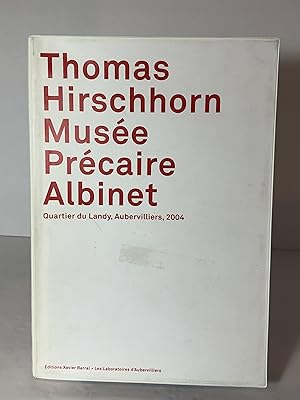Thomas Hirschhorn Yvane Chapuis Laboratoires (1 results)
Product Type
- All Product Types
- Books (1)
- Magazines & Periodicals
- Comics
- Sheet Music
- Art, Prints & Posters
- Photographs
- Maps
-
Manuscripts &
Paper Collectibles
Condition
- All Conditions
- New
- Used
Binding
- All Bindings
- Hardcover
- Softcover
Collectible Attributes
- First Edition
- Signed
- Dust Jacket
- Seller-Supplied Images
- Not Printed On Demand
Seller Location
Seller Rating
-
Thomas Hirschhorn, Musee precaire Albinet: quartier du Landy, Aubervilliers, 2004
Published by Editions Xavier Barral, 2005
ISBN 10: 2915173095ISBN 13: 9782915173093
Seller: Amatoria Fine Art Books, IOBA, CALIBA, Sacramento, CA, U.S.A.
Association Member: IOBA
Book
Condition: Very Good. Very Good, First Edition thus, 10 3/4" x 7 1/2." White plastic wrappers with red lettering to front cover and spine. Back cover has black lettering, facsimile handwriting by Thomas Hirschhorn. A few marks to covers and one piece of tape residue on front cover. Else, clean and intact, binding tight. Replete with color illustrations of Hirchhorn's project during its progressive stages. Text block clean and unmarked. Unpaginated, 400 pp., including many illustrations and printed photographs, most of which are in color, credits, and biography of Hirschhorn. Thomas Hirschhorn (b. 1957) is a Swiss artist based in Paris. He is well-known for his collages and mixed-media installations, some of which transform entire spaces using a variety of objects. The nature of Hirschhorn's art has a sociopolitical bent and addresses issues such as classism and poverty. He has made it a point to use only materials that he considers to be readily accessible to all. Chronological documentation of Thomas Hirschhorn's artwork, _Musee Precaire Albinet_ ("Precarious Museum Albinet"), with commentary by Yvane Chapuis. The Precarious Museum was a unique project made by Hirschhorn in collaboration with Laboratoires d'Aubervilliers, a cultural organization, in which he set up a pop-up art museum in a Parisian suburb located in Aubervilliers. No art museum is complete without its collection, so Hirschhorn borrowed actual artworks from the Pompidou Centre by eight artists who he felt were historically important, namely, Joseph Beuys, Le Corbusier, Salvador Dali, Marcel Duchamp, Fernand Leger, Kasimir Malevich, Piet Mondrian, and Andy Warhol. Much in line with Hirschhorn's mission of equality and inclusivity, the project was interactive, allowed master artworks to be easily viewable by the general public, and welcomed Aubervilliers residents to take part in the construction of the museum.


